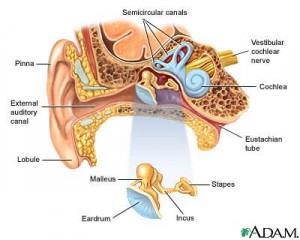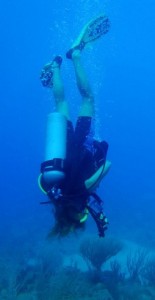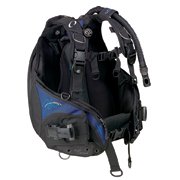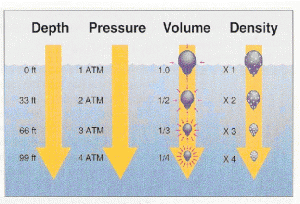In my introductory post, I explained, in basic terms, what happens to Air when you go beneath the surface of water and in Part 1 I talked about buoyancy and the relationship between Air and the BCD. In this post, I will describe the part that Air plays on our Ears and Sinuses and how we adjust our bodies to that with some super tips to help you in one of the most common challenges as new divers!
Even if you don’t know anything about scuba diving, there is a general understanding that something happens to our ears when you dive down deep and similarly when we’re on an airplane. Many people even feel afraid to give scuba diving a try because of some discomfort they felt while free-diving. Sometimes they think that the discomfort will be worse while scuba diving because typically it’s deeper than free-diving, but this is not necessarily true!
Let me first explain a little about our Ears and Sinuses… There are tubes leading from our ears and sinuses to our throats and they are filled with air. As soon as you go underwater, our bodies feel the pressure and the weight of the water on these spaces as the air inside them becomes “smaller” (read my intro for more info on why air becomes “smaller” underwater). The tubes are squeezed together by the pressure and the result is discomfort. Our goal is to maintain a normal amount of air inside this airspace and push open the tubes, so we “equalize” it to the surrounding (“ambient” pressure for each depth). We do this as soon as we go underwater and every 1m/3ft before any discomfort is felt.
It’s so easy to prevent any discomfort simply by pushing air into those spaces as you go down and we do that in 3 common ways:
1. Take a breath in through your mouth, plug your nose with your mouth now closed, and then try to breathe out your nose (while it is plugged). This will push the air from your lungs into the ear tubes and sinuses instead of out your mouth/nose where they normally go. Your Ear and Sinus air spaces open up!
2. Swallow and wiggle your jaw. You can tilt your head from side to side and try to stretch your neck to try to help your body in letting the air get inside those tubes and air spaces.
3. Do #1 while doing #2!
It’s also important to note that, as we talked about in the previous posts, not only does air change when you go down↓, but it will change when you go up↑. You will remember that, as you swim up, you must manually release air from your BCD to adjust for the expanding air; however, with our Ears and Sinuses, we are lucky in that our bodies will release the expanding air naturally for us. There is nothing you need to do with your Ears and Sinuses upon ascent.
So, just before I go into my tips, I want to point out a main difference I’ve noticed between free-diving and scuba diving with regards to equalizing your ears. Many people (including myself) feel discomfort while free-diving because the descent tends to be very rapid – you’re holding your breath after all! Whereas, with scuba diving a typical descent is slow and controlled, so you have the time to “clear” even the most sensitive of ears before ever feeling any discomfort. Just like anything else with diving, it does take practice, so make sure you take your time!
Mia’s Helpful Tips!
1. Prevention. Remember – equalizing is a preventative measure. It’s a common misconception that you should wait until you feel discomfort and then try to equalize. Don’t Wait!!
2. Having Difficulty. Don’t push too hard! The tissues inside your ears and sinuses are very delicate. If you are having difficulty equalizing, ascend up 1m/3ft where the pressure is less and try again.
3. Cold and Allergies. If you have a cold or allergies, the tubes and sinus air spaces will be swollen and filled with mucous (fluids). You won’t be able to push air into these areas sufficiently OR the air that does get in may not be able to get out upon ascent. As you swim up, it will expand inside the tubes and sinuses resulting in much pain called a Reverse Block and possibly permanently damaging these delicate tissues. Try snorkeling on days that you have a cold/allergies! Sometimes the salt water is just as good as a nasal spray with saline solution to get those boogies out!
4. Changing depth. Remember – equalizing is not limited to your first descent along a line. As you follow a sloping bottom, don’t forget to continue to equalize. You will always need to adjust the amount of air inside those spaces depending on whichever depth you go to.
5. Ear Plugs. If your ears are prone to infection, you may be using ear plugs. My preferred ones are Doc’s Pro Plugs. Make sure you purchase the ones with a pin hole so air is able to escape upon your ascent!
6. Cleaning. I usually use a half and half mixture of alcohol and vinegar after I’ve been in the water. The alcohol dries out all those little crevices in your ear that are prone to infection and the vinegar gives it all a good clean (and you get to smell like fish and chips – Yum!)
As you may be aware, I began this 5 part series with a goal of addressing some common queries I get from various dive students as well as certified divers. While everyone receives the same training from PADI around the world, a lot of the practical tidbits of useful information are shared pre and post-dive on the boat or over a beer at the end of the day. I know for me when I first started out diving, I only had the chance to dive maybe twice a year if I was lucky, so my learning curve was slow. I’m hoping that these blogs will be able to provide some additional insights my divers can refer back to. I hope you enjoy and feel free to let me know what you think via my DiveWithMia Facebook page or click on Contact Mia!




